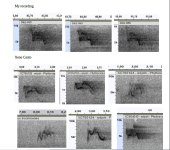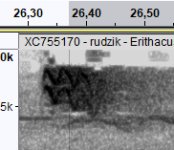-
Welcome to BirdForum, the internet's largest birding community with thousands of members from all over the world. The forums are dedicated to wild birds, birding, binoculars and equipment and all that goes with it.
Please register for an account to take part in the discussions in the forum, post your pictures in the gallery and more.
You are using an out of date browser. It may not display this or other websites correctly.
You should upgrade or use an alternative browser.
You should upgrade or use an alternative browser.
Greenish warbler call? (1 Viewer)
- Thread starter Michał Jaro
- Start date
More options
Who Replied?Michał Jaro
Well-known member
First thanks for your reaction!
I wrote: Poland (I can add southern, although it doesn't matter for this species)
I didn't see the bird, if I did, I probably wouldn't post this I know the calls of all native warblers, pipits, etc. These calls doesn't remind me of these calls, then I checked it on Xeno Canto, I also compared the spectrograms and it seems to me that the voice is very similar to the calls of the greenish warbler. So - please help, if ypu know greenish warblers.
I know the calls of all native warblers, pipits, etc. These calls doesn't remind me of these calls, then I checked it on Xeno Canto, I also compared the spectrograms and it seems to me that the voice is very similar to the calls of the greenish warbler. So - please help, if ypu know greenish warblers.
I wrote: Poland (I can add southern, although it doesn't matter for this species)
I didn't see the bird, if I did, I probably wouldn't post this
Site, town, region, whatever, etc. Enough so that we can locate it on a map. Poland is a vast area - southern Poland is only half as vast.Could you always give the actual location? Thanks.
Michał Jaro
Well-known member
thanks
Yes, but in the case of Phylloscopus trochiloides, it does not matter where in Poland the observation was made - the probability is similar throughout Poland.
Yes, but in the case of Phylloscopus trochiloides, it does not matter where in Poland the observation was made - the probability is similar throughout Poland.
Not sure why this is such hard work...
1. Suppose your sound is not that of a greenish warbler (and you are, after all, asking for its ID because you don't know it)? Suppose someone thinks it's something else and wants to see if the distribution of that something-else matches your record?
2. Suppose someone wants to know the location just because they enjoy knowing? (this sort of background info makes topics a more-interesting read, even for those that can't help directly with the ID - and this forum's audience consists largely of such people - it doesn't exist merely to provide a free ID service for posters).
3. See the sticky topic: Please Read Before Posting To The Id Forum
'The more locational information you provide in the title of the post, the more likely it is that people knowledgeable about the birds of your area will bother to take a look at it. Country--region--state/province--county--town, the further down the location tree you go, the better.' [my bold]
It really is just a whole lot easier to provide this information, automatically and without regard to other issues, for every discussion topic - rather than going through a whole debate (with yourself or with others) about whether it will/might/won't be helpful/necessary in a specific ID case - and still making the wrong decision.
1. Suppose your sound is not that of a greenish warbler (and you are, after all, asking for its ID because you don't know it)? Suppose someone thinks it's something else and wants to see if the distribution of that something-else matches your record?
2. Suppose someone wants to know the location just because they enjoy knowing? (this sort of background info makes topics a more-interesting read, even for those that can't help directly with the ID - and this forum's audience consists largely of such people - it doesn't exist merely to provide a free ID service for posters).
3. See the sticky topic: Please Read Before Posting To The Id Forum
'The more locational information you provide in the title of the post, the more likely it is that people knowledgeable about the birds of your area will bother to take a look at it. Country--region--state/province--county--town, the further down the location tree you go, the better.' [my bold]
It really is just a whole lot easier to provide this information, automatically and without regard to other issues, for every discussion topic - rather than going through a whole debate (with yourself or with others) about whether it will/might/won't be helpful/necessary in a specific ID case - and still making the wrong decision.

While it can't be treated as conclusive, have you tried running your call through Merlin and BirdNET? BirdNET says 1) Greenish Warbler (100%) and 2) Spotted Flycatcher (56%). Merlin has Greenish Warbler, Chaffinch, Blackcap, Willow Warbler and Spotted Flycatcher.
Whether the call is diagnostic I can't tell, but I think xeno canto has the answer--you can type 'seen:no' at the end of the search parameters to browse birds that weren't seen (those that were identified only by sound): Greenish Warbler (Phylloscopus trochiloides) :: xeno-canto. If enough non-novice XC recordists have identified the bird based on a call like yours, then odds are that it's distinctive.
EDIT: You may have misgivings, but here's my take: distinctiveness = whether one would identify a bird based solely on a given feature. People uploading sounds of birds they haven't seen (sort of) vouch for the correctness of the ID with their experience and would probably reiterate their stance when asked personally. If the sum of their experience is considerable, you can be relatively sure that your identification is similarly good (this assumes your recording compares favourably with theirs, but you said it does).
Whether the call is diagnostic I can't tell, but I think xeno canto has the answer--you can type 'seen:no' at the end of the search parameters to browse birds that weren't seen (those that were identified only by sound): Greenish Warbler (Phylloscopus trochiloides) :: xeno-canto. If enough non-novice XC recordists have identified the bird based on a call like yours, then odds are that it's distinctive.
EDIT: You may have misgivings, but here's my take: distinctiveness = whether one would identify a bird based solely on a given feature. People uploading sounds of birds they haven't seen (sort of) vouch for the correctness of the ID with their experience and would probably reiterate their stance when asked personally. If the sum of their experience is considerable, you can be relatively sure that your identification is similarly good (this assumes your recording compares favourably with theirs, but you said it does).
Last edited:
Mark Lew1s
My real name is Mark Lewis
Surely recordings where the bird has been seen are much more reliable sources than recordings where the bird hasn’t been seen. We have no idea whether those who upload sounds know what they’re listening to. Only using ‘unseen’ recordings adds an element of gamble that is reduced with recordings of seen birds.

That's true, although then we have no way of checking whether the call is distinctive. Yes, it would be best to (1) compare with the calls of seen birds. However, after we know that the calls indeed match, we can then (2) double-check whether this particular type of call is considered distinctive by other recordists = enough to tick a bird without seeing it. In (1) we want to see whether it's right for a given species, while in (2) we want to see whether it's wrong for other potentially similar species in a given region. Fortunately, Green Warbler would be massively out of range in Poland.
While this is not the case with Greenish Warbler, with Tawny Pipit marking 'seen:no' gave me the additional benefit of browsing what I think were nocturnal flight calls, which was useful because a flight call was what I was after.
While this is not the case with Greenish Warbler, with Tawny Pipit marking 'seen:no' gave me the additional benefit of browsing what I think were nocturnal flight calls, which was useful because a flight call was what I was after.
Mark Lew1s
My real name is Mark Lewis
I think the logic is sound here but it relies on recorders never getting anything wrong - and we all know that can’t be the case. The dataset of recordings of seen birds almost certainly has fewer errors than the dataset of recordings of unseen birds, for almost all species (apart perhaps for distinct sounding elusive species such as bittern or corncrake).
I don’t think that a call can automatically be classed as ‘distinctive’ just because some recorders believe they can identify the bird without seeing it. Likewise, there are levels of ‘distinctiveness’. An accomplished nocmigger might have no issue separating black-tailed from bar-tailed godwit - but to someone with very little experience, the subtle differences between those two species may not be obvious from a simple comparison of a sample from XC.
I don’t think that a call can automatically be classed as ‘distinctive’ just because some recorders believe they can identify the bird without seeing it. Likewise, there are levels of ‘distinctiveness’. An accomplished nocmigger might have no issue separating black-tailed from bar-tailed godwit - but to someone with very little experience, the subtle differences between those two species may not be obvious from a simple comparison of a sample from XC.
Michał Jaro
Well-known member
Thank you very much for joining the discussion and interesting opinions!
However, I don't agree with everything.
Beyond doubt, there are a whole bunch of calls that are considered diagnostic - and you don't need to see the bird at all. They are so characteristic in sound - or in the sonogram. There is only one question - has anyone analyzed the call of a given bird and whether experts consider it diagnostic. This is a scientific issue.
As for the greenish warbler: I'm posting a louder recording and a list of sonograms (IMO quite similar). My interest in this voice arose after reading the description in the Collins guide, where Greenish's Warbler voice is compared to that of a White Wagtail. Listen, doesn't these calls sound a bit like a white wagtail?
However, I don't agree with everything.
Beyond doubt, there are a whole bunch of calls that are considered diagnostic - and you don't need to see the bird at all. They are so characteristic in sound - or in the sonogram. There is only one question - has anyone analyzed the call of a given bird and whether experts consider it diagnostic. This is a scientific issue.
As for the greenish warbler: I'm posting a louder recording and a list of sonograms (IMO quite similar). My interest in this voice arose after reading the description in the Collins guide, where Greenish's Warbler voice is compared to that of a White Wagtail. Listen, doesn't these calls sound a bit like a white wagtail?
Attachments
Michał Jaro
Well-known member
I feel very very uneasy about the repeated implication - occasionally even insistence - in these columns, from some quarters, that one can commonly identify with certainty a poorly-known or poorly-distinguished bird call from a recording and without having seen the bird.
Michał Jaro
Well-known member
If it is indeed a poorly known or poorly recognized voice then I agree. The problem is that when I add a post here, I don't know if a given voice is poorly recognized.
poorly-distinguished
Users who are viewing this thread
Total: 2 (members: 0, guests: 2)





